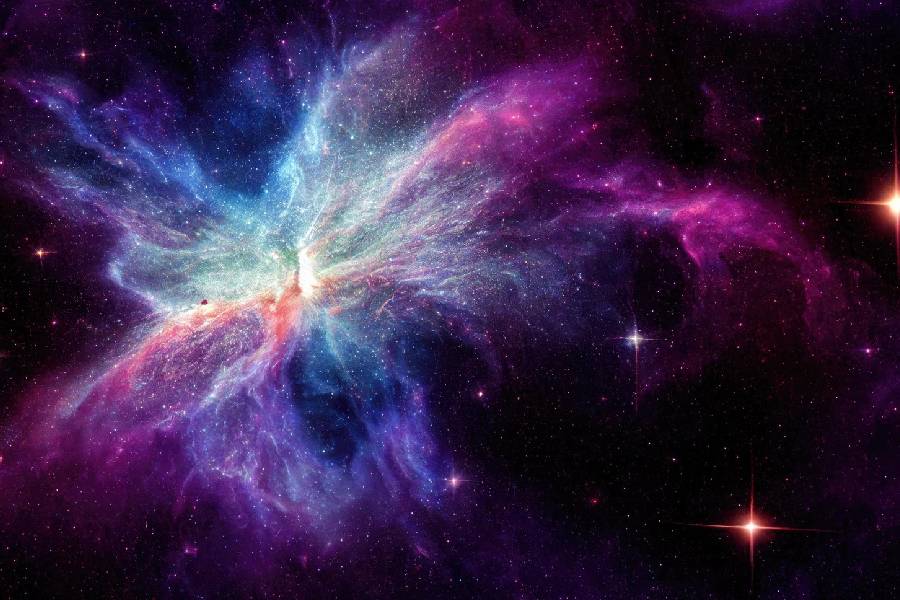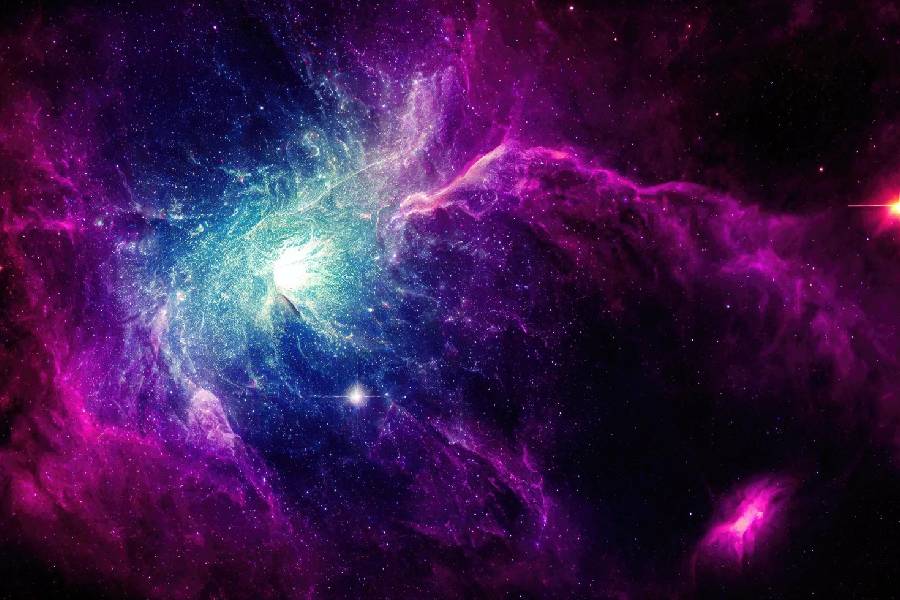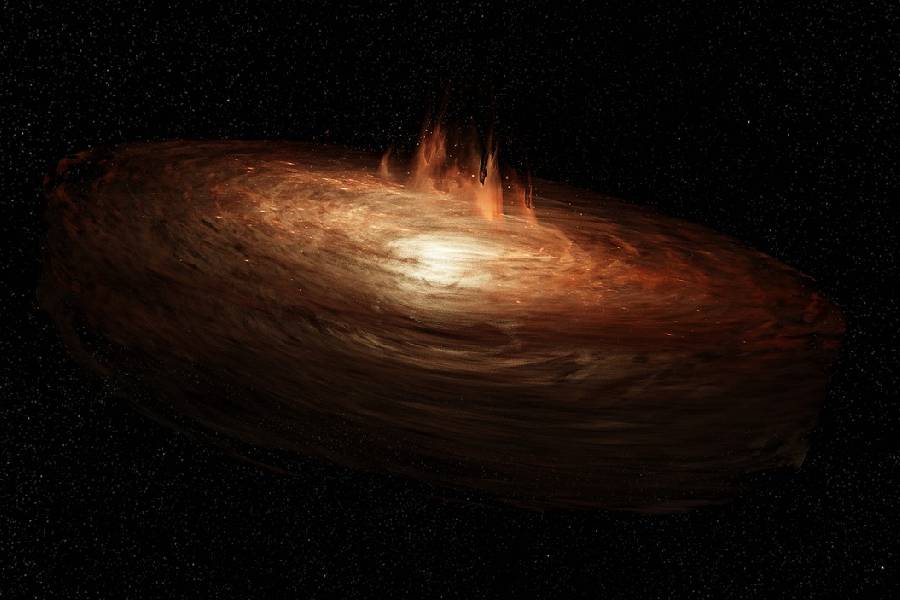What is an active galactic nucleus? An active galactic nucleus (AGN) is a powerful, energetic core at the center of some galaxies. It is fueled by the accretion of mass onto a supermassive black hole.
As fascinating objects, AGNs play a crucial role in shaping the evolution of galaxies. Scientists believe that the activity in an AGN is driven by the intense gravitational forces and interactions within the galactic center. But what causes this, and what is an active galactic nucleus exactly?
This article will cover the active galactic nucleus definition and highlight the key features that distinguish it from normal galactic cores. We’ll explore the theoretical frameworks and observational evidence behind black hole-fueled emission models that power their extreme energetic output.
Delving into multiwavelength analysis, we’ll reveal the diverse signatures of gas swirling around the black hole on its way to oblivion. By directly observing some of the most energetic phenomena in our universe occurring in AGNs, we can hope to better understand the evolution of galaxies.
What Is an Active Galactic Nucleus?
What is an active galactic nucleus? An active galactic nucleus (AGN) is a powerful, energetic core at the center of some galaxies. It is fueled by the accretion of mass onto a supermassive black hole.
This process causes it to emit intense radiation across the spectrum, displaying features like jets and strong radio emissions. The study of AGNs provides insights into extreme environments around black holes and their impact on galaxy evolution.

What Are Active Galactic Nuclei – The Basics
The core of celestial energy
The heart of an active galactic nucleus is the supermassive black hole lurking in the core. Ranging from millions to billions of solar masses, its staggering gravitational influence fuels the chaos within AGNs. Surrounded by a rotating disk of superheated accretion material, immense energies are unleashed as matter swirls toward its doom.
The cosmic eruption – Understanding AGN phenomena
So, what transforms once-quiescent galaxies into active galactic nuclei? The key driver is the dramatic inflow of gas, dust, and other matter into the central region, likely sparked by galactic mergers or collisions.
Tremendous gravitational and magnetic forces channel some of this material onto decisive paths straight into the gaping maw of the central supermassive black hole. Friction and immense pressures create a fiery disk that releases copious amounts of high-energy radiation visible across the universe.
Characteristics of Active Galactic Nuclei
Luminosity and intensity – The AGN signature
The hallmark calling card of any active galactic nucleus is the sheer strength of its energy output across multiple wavelengths from radio waves through X-rays.
AGNs can briefly outshine the integrated luminosity of the hundreds of billions of stars that otherwise dominate their host galaxy. Careful analyses of emission lines, variability, and more allow definitive separation from stellar processes.
Dynamic features – Jets, X-rays, and beyond
What powers active galactic nuclei? Delving deeper, AGNs reveal diverse structural details related to the physics of gas accretion, black hole spin, and magnetic fields. Collimated jets spitting out energetic particles at near-light speed can stretch for thousands of light years.
Hard X-rays and gamma rays penetrate obscuring dust, offering a direct diagnosis of black hole feeding processes. Radio waves reveal expanding lobes inflated by the jets’ termination shocks. Together, these features trace the complex anatomy powering AGNs.
The Role of Supermassive Black Holes
Black hole fueling – The heart of AGN activity
As mentioned above, at the core of active galactic nuclei (AGN) lies a cosmic powerhouse – the supermassive black hole. Black hole fueling, the process of material falling into the gravitational embrace of these celestial behemoths, stands as the heartbeat of AGN activity.
Accretion disk anatomy
As doomed matter descends, angular momentum spins it up into a swirling flat disk structure encircling the black hole. Frictional nuclear fires heat the accretion disk to millions of degrees, reaching hotter than the surface of most stars.
Magnetic fields arise from the maelstrom, threading the chaos with extra tension. Together, these forces generate enough energy to outshine entire galaxies.
Relativistic jets – High-energy outflows
Not all material heads irreversibly inwards. Some get redirected outwards in relativistic jets blasting particles at over 90% the speed of light! These jets extend for astonishing distances, longer than galaxies themselves.
They remain collimated by helical magnetic fields coiled tight by the spin of the black hole. The jets pierce through the host galaxies, spreading heat and light. Detecting these beamed emissions provides key insights into the workings of AGNs.
Impact on galactic evolution
This powerful output couples the black hole to the host galaxy itself over immense spans of time and space. Radiative and kinetic feedback alters the interstellar ecosystems.
Outflows both trigger and squelch star formation in different regions. Understanding this intimate link across cosmic scales represents an exciting frontier in the study of galaxies across the universe.
Unraveling the mysteries of accretion
- Accretion processes – Understanding the intricacies of accretion is paramount to deciphering AGN behavior. Different modes, such as radiatively efficient and inefficient accretion, contribute to the diverse manifestations observed in AGNs.
- Accretion disks and luminosity – Accretion disks play a pivotal role in determining the luminosity of AGNs. The manner in which material accretes onto the supermassive black hole influences the brilliance of these cosmic phenomena, ranging from quiescent to highly active states.
- Triggering AGN activity – Various mechanisms, including galaxy mergers and interactions, can trigger enhanced accretion onto supermassive black holes, awakening AGNs. Unraveling the triggers and timelines of accretion events unveils essential clues about AGN evolution.
Emission Across the Electromagnetic Spectrum
Radio waves to X-rays – AGN’s dazzling display
AGNs emit radiation spanning the electromagnetic spectrum, showcasing a spectacular array of phenomena. This section delves into the diverse emissions – from radio waves to X-rays – that contribute to AGN’s dazzling cosmic display.
- Radio emissions – Powerful radio waves emanate from AGNs, often originating in the jets. Observing these emissions unveils valuable insights into the characteristics of AGN jets, their velocities, and the surrounding interstellar medium.
- Optical and infrared emissions – AGNs manifest in optical and infrared wavelengths, offering a glimpse into the surrounding environments and the nature of the accretion disk. These emissions aid astronomers in constructing detailed models of AGN structures.

Probing the Cosmos – Tools for AGN Observation
Ground-based telescopes
Observatories equipped with advanced instruments on Earth play a crucial role in AGN studies. Ground-based telescopes capture emissions across various wavelengths, contributing to our understanding of AGN properties.
Space observatories
Instruments aboard space observatories, such as the Hubble Space Telescope and Chandra X-ray Observatory, provide unparalleled views of AGNs. Orbiting above Earth’s atmosphere, these telescopes circumvent atmospheric interference, enabling high-resolution observations.
Multi-wavelength surveys
Combining data from different telescopes and surveys across the electromagnetic spectrum facilitates a comprehensive exploration of AGNs. Multi-wavelength observations uncover the complexity and diversity inherent in these cosmic phenomena.
Variability of Active Galactic Nuclei
AGN’s cosmic dance – Understanding flares and changes
Active galactic nuclei (AGNs) are not static entities but rather cosmic performers engaged in an intricate dance. This section explores the dynamic flares and changes that characterize their celestial choreography.
Timing black hole meals
Like a strobe light, AGNs brighten and dim over days to years, flaring up at some wavelengths dramatically while quieting at others.
These intricate patterns reflect how the magnetic monster gobbles up its meal. Tracking the rise and fall of X-rays charts the last hours of matter orbiting tighter, while ultraviolet and optical light echoes off hot clouds further out.
Anatomy in motion
Zooming into the tempestuous swirl, structures rearrange in a choreographed dance to feed the cosmic drain. Magnetic flux tubes realign, their tension mounting then snapping in flash-bang instabilities shooting particles out in beams.
Meanwhile disk fragments stretch, shear, and spiral inward, some shred apart and join the black hole buffet. This orchestrated mayhem powers the flickering fires of active galaxies.
Feast & famine cycles
Sometimes the fuel supply surges, other times it trickles in a bare subsistence diet. When galaxies collide, their gas-rich innards get stirred up, rain down, and are swallowed vigorously, exponentially increasing brightness.
But the gluttony cannot last forever. Eventually the pantry shelves empty, and the AGN fades until the next feast. These waxing and waning binges trace out galactic evolution occurring in fast forward.
Time-scale dynamics – Observing AGN transformations
- Short-term and long-term variations – AGNs exhibit changes on varying time scales. Short-term variations may occur over days or weeks, reflecting rapid processes, while long-term variations span months or years, providing a broader perspective on AGN transformations.
- Time-resolved observations – Observing AGN transformations requires a temporal lens. Time-resolved observations, facilitated by advanced telescopes and monitoring campaigns, enable astronomers to capture the nuanced evolution of AGNs, unraveling the mysteries of their dynamic behavior.
- Implications for AGN understanding – Decoding the time-scale dynamics of AGNs enhances our comprehension of the underlying physical mechanisms. Whether witnessing a sudden flare or a gradual shift, these temporal variations serve as cosmic clues guiding us toward a deeper understanding of AGN intricacies.
Types of Active Galactic Nuclei
Seyfert galaxies – AGNs in spiral galaxies
Seyfert galaxies, nestled within the vast arms of spiral galaxies, host a particular class of AGNs. They reside within the spiral arms of host galaxies like our Milky Way and have a close cosmic connection. The energetic output from Seyfert AGNs can influence the surrounding interstellar medium, affecting star formation rates and galactic dynamics.
Seyfert galaxies are classified into two main types – Seyfert I and Seyfert II – based on their spectroscopic features. Seyfert I galaxies display broad emission lines, while Seyfert II galaxies exhibit narrower lines, providing clues about the orientation of the accretion disk.
Quasars – Distant, luminous AGN beacons
Quasars, or quasi-stellar radio sources, represent a luminous and distant subclass of AGNs. These celestial beacons outshine entire galaxies, and their discovery revolutionized our understanding of the early universe.
Quasars derive their luminosity from the accretion of mass onto supermassive black holes. Their brilliance allows astronomers to study the universe’s distant epochs, providing crucial insights into cosmic evolution and the interplay between AGNs and their cosmic surroundings.

Conclusion
Through this deep dive into AGN’s meaning and role, we hope your perspective on the centers of galaxies has expanded greatly. We explored how these tiny central regions can transform into energetic phenomena when ample gas triggers increased feeding of the supermassive black holes lurking at the hearts of galaxies.
Delving into their intense emissions across the electromagnetic spectrum and the effects of particle jets on galactic evolution, this article brings more clarity around the subject of what is an active galactic nucleus. From the physics of accretion disks to unlocking triggers for renewal of activity, many mysteries still swirl within these active cores.
But armed with a stronger grasp on the diverse and dazzling display arising in active galactic nuclei, you now have critical keys for interpreting what telescopes showcase from the dynamic centers of galaxies across our universe.
